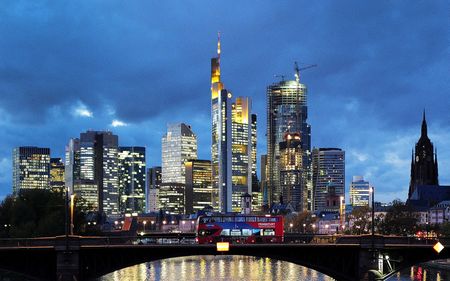By Maria Martinez
BERLIN (Reuters) -The German economy grew significantly more in the first quarter than previously estimated due to export and industry frontloading ahead of U.S. tariffs, according to a second estimate published on Friday.
The economy grew by 0.4% in the first quarter of 2025 compared with the previous quarter, the statistics office said, revising a preliminary reading of 0.2%.
Germany had contracted in the final quarter of last year by 0.2%, reigniting recession fears. A recession is defined as two consecutive quarters of negative growth.
Manufacturing output and exports registered stronger growth than initially assumed in March, said Ruth Brand, president of the statistics office, explaining the revision. U.S. importers brought their purchases forward in anticipation of tariffs.
Europe’s biggest economy outperformed the euro zone average growth rate of 0.3% in the first quarter, the statistics office noted.
“Today’s numbers finally brought back an almost forgotten relic from the past: the German economy can still surprise to the upside,” said Carsten Brzeski, global head of macro at ING, although he added that this will likely be a one-off.
Germany’s sluggish economy has not grown at that pace since the third quarter of 2022, when it expanded by 0.6%.
The big question is whether at least part of this momentum can be carried into the coming quarters.
In terms of exports and manufacturing production, the second quarter is likely to be more subdued, as preemptive effects due to announced tariffs have played an important role, said Cyrus de la Rubia, chief economist at Hamburg Commercial Bank.
However, a cyclical component is also observable in manufacturing – as early indicators up to May show – and the strength in consumption is what could have been expected for some time given real wage increases, de la Rubia said.
“Therefore, there are several reasons to believe that the upward trend will continue here,” he said.
Brzeski said that in the short run, the negatives will outweigh the positives, even though there are finally tentative signs of a turning inventory cycle, which normally bodes well for industrial production over the coming months.
“In the longer term, however, there are good reasons to be more optimistic,” Brzeski said, mentioning the 500-billion-euro infrastructure fund approved by Germany’s parliament in March.
German economic growth in the first quarter was driven by trade and consumption.
Exports rose by 3.2% compared to the previous quarter and household consumption saw stronger growth than in the preceding quarters, rising by 0.5%.
By contrast, government spending declined by 0.3% in the first quarter compared to the previous one. According to the statistics office, this is due to the provisional budget.
After former chancellor Olaf Scholz’s coalition collapsed in November, the last government ran out of time to pass the 2025 budget. Germany has instead been operating on a provisional budget since the start of the year.
Investment also increased by 0.9% in the first quarter, compared to the last quarter of 2024.
($1 = 0.8834 euros)
(Reporting by Friederike Heine and Maria Martinez, editing by Thomas Seythal and Toby Chopra)










